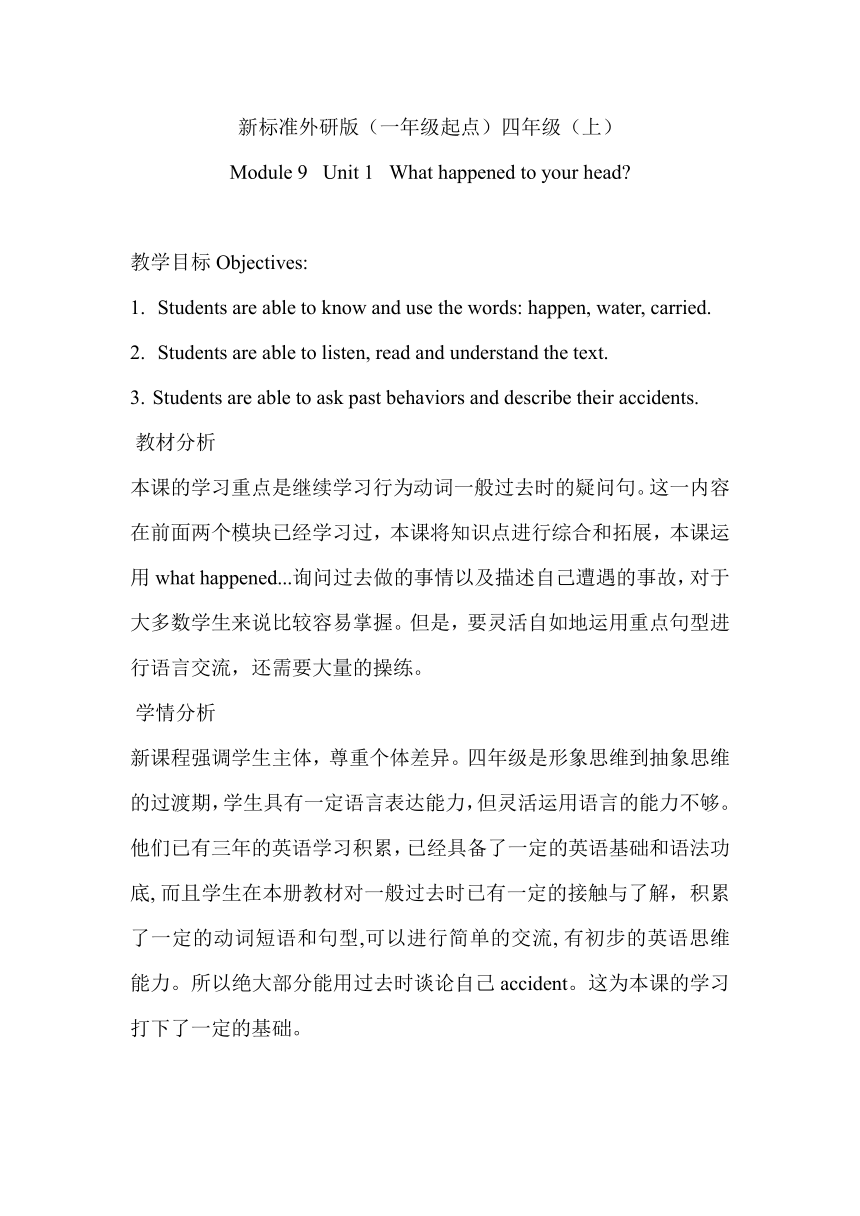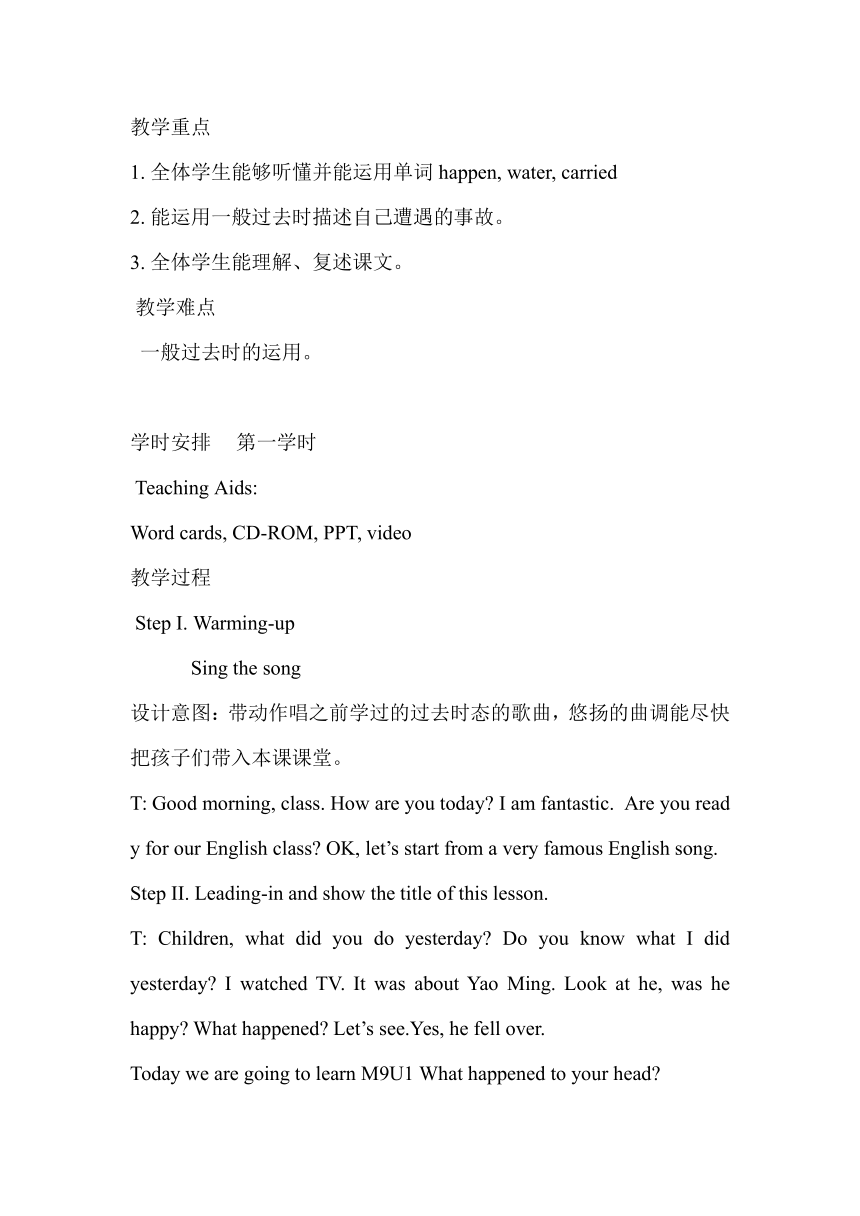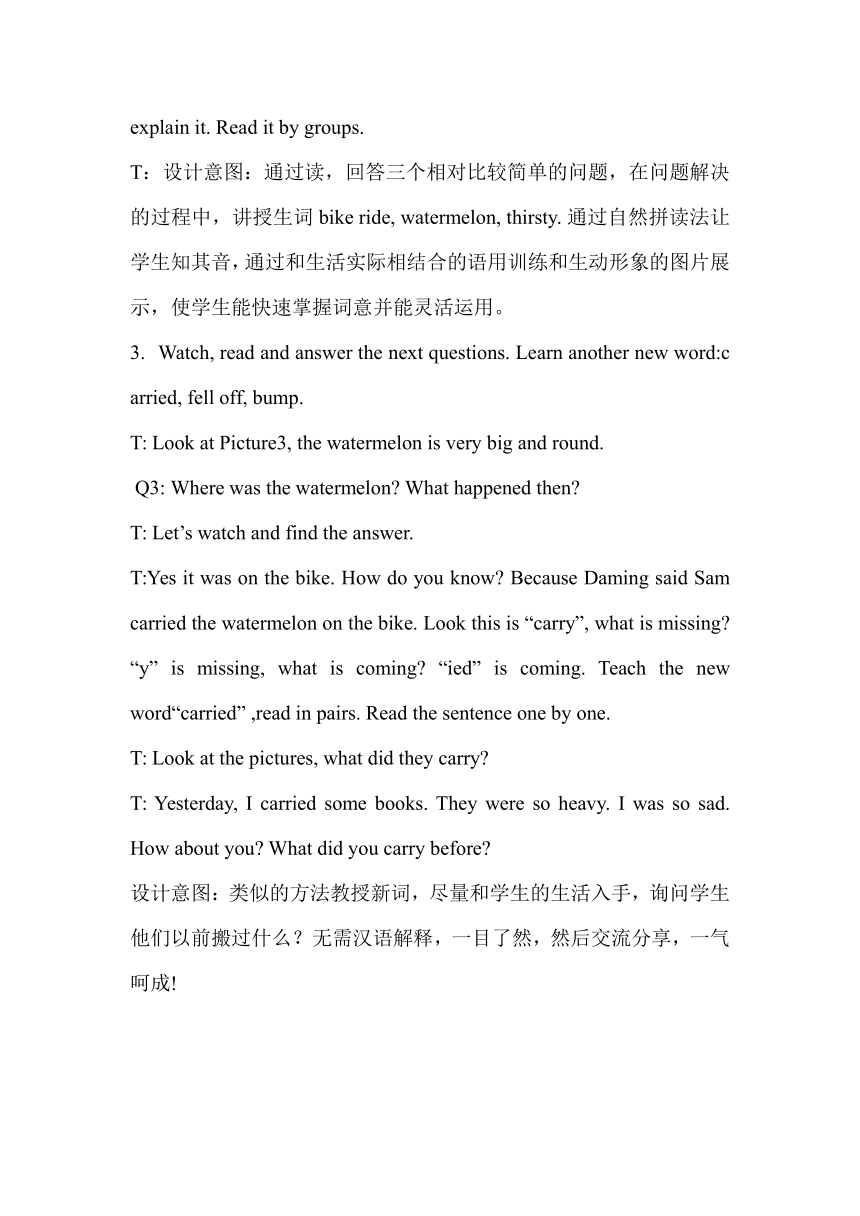外研版(一起)四上 Module 9 Unit 1 What happened to your head 教案
文档属性
| 名称 | 外研版(一起)四上 Module 9 Unit 1 What happened to your head 教案 |

|
|
| 格式 | doc | ||
| 文件大小 | 106.5KB | ||
| 资源类型 | 教案 | ||
| 版本资源 | 外研版(一年级起点) | ||
| 科目 | 英语 | ||
| 更新时间 | 2021-08-05 11:17:29 | ||
图片预览




文档简介
新标准外研版(一年级起点)四年级(上)
Module?9???Unit?1???What happened to your head?
教学目标?Objectives:?
?Students are able to?know?and?use?the?words:?happen, water, carried.
?Students are able to?listen,?read?and?understand?the?text.?
Students are able to ask past behaviors and?describe their accidents.??
?教材分析??
本课的学习重点是继续学习行为动词一般过去时的疑问句。这一内容在前面两个模块已经学习过,本课将知识点进行综合和拓展,本课运用what happened...询问过去做的事情以及描述自己遭遇的事故,对于大多数学生来说比较容易掌握。但是,要灵活自如地运用重点句型进行语言交流,还需要大量的操练。?
?学情分析??
新课程强调学生主体,尊重个体差异。四年级是形象思维到抽象思维的过渡期,学生具有一定语言表达能力,但灵活运用语言的能力不够。他们已有三年的英语学习积累,已经具备了一定的英语基础和语法功底,?而且学生在本册教材对一般过去时已有一定的接触与了解,积累了一定的动词短语和句型,可以进行简单的交流,?有初步的英语思维能力。所以绝大部分能用过去时谈论自己accident。这为本课的学习打下了一定的基础。
教学重点??
1.?全体学生能够听懂并能运用单词happen, water, carried??
2.?能运用一般过去时描述自己遭遇的事故。????
3.?全体学生能理解、复述课文。?
?教学难点?
??一般过去时的运用。
学时安排?????第一学时
?Teaching?Aids:?
Word?cards,?CD-ROM,?PPT,?video?
教学过程?
?Step?I.?Warming-up??
Sing?the?song
设计意图:带动作唱之前学过的过去时态的歌曲,悠扬的曲调能尽快把孩子们带入本课课堂。?
T:?Good?morning,?class.?How?are?you?today??I?am?fantastic.??Are?you?ready?for?our?English?class??OK,?let’s?start?from燼爒ery爁amous燛nglish爏ong.
Step營I.燣eading-in燼nd爏how爐he爐itle爋f爐his爈esson.
T:燙hildren, what did you do yesterday? Do you know what I did yesterday? I watched TV. It was about Yao Ming. Look at he, was he happy? What happened? Let抯 see.Yes, he fell over.
Today爓e燼re爂oing爐o爈earn燤9U1燱hat happened to your head?牋
1.燬how爐he爐itle.
?设计意图:以姚明摔倒为导入口,干脆利索得导入本课题,不拖泥带水。
?2.?Leading?in?the?text.?
T:?Look at Daming’s head, what do you want to ask??Let’s say: What happened to your head? Teach the new word: happen-happened
Step?III.?Presentation.?Listen?and?say.
?Watch?and?match??
?T:?Here are four pictures, it was about an accident. But they are not in right place. Let’s watch and put them in right place.??
设计意图:通过直观形象的课文FLASH?观看,先找出首要信息。?
2.?Read?and?answer?
Q1:?What did they do yesterday?
Q2: What did they buy???
T:?Please?open?your?books?and爐urn爐o燤9U1,爌lease爎ead燼nd爐ell爉e爐he燼nswer.
Q1.2:燱hat did they do yesterday? What did they buy?
Teach爐he爊ew爓ord爴bike ride, watermelon with the word cards and some pictures and read them by boys and girls.
T:燱hy did they buy a watermelon?牋
T:燳es, they were hungry and thirsty.Are you thirsty now? If you are thirsty, what can you do?Teach the word爴thirsty and do the action to explain it. Read it by groups.
T:设计意图:通过读,回答三个相对比较简单的问题,在问题解决的过程中,讲授生词bike ride, watermelon, thirsty.?通过自然拼读法让学生知其音,通过和生活实际相结合的语用训练和生动形象的图片展示,使学生能快速掌握词意并能灵活运用。?
?Watch,?read?and?answer?the?next?questions.?Learn?another?new?word:carried, fell off, bump.
T:?Look at Picture3, the watermelon is very big and round.
燪3:燱here was the watermelon? What happened then?
T:燣et抯爓atch燼nd爁ind爐he燼nswer.
T:Yes it was on the bike. How do you know? Because Daming said Sam carried the watermelon on the bike. Look this is 揷arry, what is missing? 搚 is missing, what is coming? 搃ed is coming. Teach the new word揷arried ,read in pairs. Read the sentence one by one.
T:燣ook at the pictures, what did they carry?
T: Yesterday, I carried some books. They were so heavy. I was so sad. How about you? What did you carry before?
设计意图:类似的方法教授新词,尽量和学生的生活入手,询问学生他们以前搬过什么?无需汉语解释,一目了然,然后交流分享,一气呵成!
T:?Look at picture 4, do you think it’s a good idea? What do you want to ask?
Q4:?What happened to Daming? What happened to Sam?
?T:?Sam fell off his bike. Teach the new words 揻ell off Read the new words by groups. Look at the pictures, what happened?
T: Daming bumped his head. Teach the new word bumped攁nd read one by one.I need two students to help me. Look, they were late for school and they were in a hurry. What happened?
T:So where did they go? Sam took Daming and the watermelon to the hospital.
设计意图:通过大量fell off he bump图片,并加入学生的表演,激发学生学习兴趣,使孩子们理解课文中所说的词汇含义并在实际生活中运用。
?Step?IV?Practice?
1.?Watch?and?repeat?.Pay?attention?to?the?tone,?the?emotion,?the?stress?and?the?pause.
Read?by?yourselves.?
Fill in the blanks.??
Retell?the?accident by using “who, when, where, what, what happened ”
T:?You?did?a?great?job.?We know bumped, we add “ed”, this is the regular past tense.
Today let’s know more about past tense.
设计意图:模仿跟读的语音训练, 通过看画面配音,以及自读精读,乃至最后的展示,检测学生听读模仿练习的学习效果.练习有梯度有层次,由易到难,最后转述课文,以第三人称,层层递进,学生学会水到渠成最后播放一般过去时微课视频,让学生整体学习时态,层层递进,提升语言说和读方面的基本功能力水平,使他们进一步加深对课文的理解和掌握。为下一步的转述打好基础。?
6.Watch a movie and make a dialogue in pairs.
T:?Now let’s check, I divide you into two groups. Boys vs girls. Come on. First, let’s see a movie and see what happened to the bear? What did he do?
T: Look, there are some pictures for you. Each picture has some helpful words. Work in pairs, make your dialogue.
Play a guessing game.
T: Next, let’s play a guessing game. Two questions are here. Let’s read.You can answer Maybe he... and he... ( Lady first).
?设计意图:在上一步骤里已经逐渐让孩子们进行了大量的听读训练,从模仿跟读到内化为自己的语音语调,这一环节更加突出语用功能,大量输出。
Step?V.?Extension?and?Task?
?See a movie about Goofy.
T: Children, you are so great today. I prepare a movie for you .He is our new friend, Goofy.Let’s say hello to Goofy. What do want to know?
设计意图:通过介绍英文goofy滑雪视频,激发学生学习兴趣。让学生提问问题,培养学生独立思考能力,并且通过视频回答问题,提升学生表达能力以及语用能力,为下一步谈论自己的事故铺路。
?Read my painful accident and let students tell their accidents.
T:?It was so funny. At the same time, he had a painful accident. I had a painful accident, too.
T:?Children, did you have a painful accident? Work in groups of four, talk your own accident.
?T:?All right.?Who?can?share?with?us??(Ask?two?or?three)
设计意图:通过goofy视频拓展到描述自己的事故,动静结合,通过前面的层层铺垫,最后学生的自己的语用拓展上,根据提示描述自己的事故计划安排,通过合作互助,加上所给的提示,降低难度,再自己写出来,最后全班分享,语篇的完成水到渠成。
?Step?VI.?Emotional education?
T:?From this class, we know danger is everywhere.Let’s enjoy a video.
T: In one word, live happily and safely.
?Step?VII.?Homework?
1.?Listen,?repeat?and?recite?the?passage.?
2.?Finish?your?paper?and?talk??with?your?family.?
T:?So?much?for?this?lesson,?be careful and keep safe.?Class?is?over,?bye!
Step VIII. Board design
Module 9 Unit 1
What happened to your head?
Module?9???Unit?1???What happened to your head?
教学目标?Objectives:?
?Students are able to?know?and?use?the?words:?happen, water, carried.
?Students are able to?listen,?read?and?understand?the?text.?
Students are able to ask past behaviors and?describe their accidents.??
?教材分析??
本课的学习重点是继续学习行为动词一般过去时的疑问句。这一内容在前面两个模块已经学习过,本课将知识点进行综合和拓展,本课运用what happened...询问过去做的事情以及描述自己遭遇的事故,对于大多数学生来说比较容易掌握。但是,要灵活自如地运用重点句型进行语言交流,还需要大量的操练。?
?学情分析??
新课程强调学生主体,尊重个体差异。四年级是形象思维到抽象思维的过渡期,学生具有一定语言表达能力,但灵活运用语言的能力不够。他们已有三年的英语学习积累,已经具备了一定的英语基础和语法功底,?而且学生在本册教材对一般过去时已有一定的接触与了解,积累了一定的动词短语和句型,可以进行简单的交流,?有初步的英语思维能力。所以绝大部分能用过去时谈论自己accident。这为本课的学习打下了一定的基础。
教学重点??
1.?全体学生能够听懂并能运用单词happen, water, carried??
2.?能运用一般过去时描述自己遭遇的事故。????
3.?全体学生能理解、复述课文。?
?教学难点?
??一般过去时的运用。
学时安排?????第一学时
?Teaching?Aids:?
Word?cards,?CD-ROM,?PPT,?video?
教学过程?
?Step?I.?Warming-up??
Sing?the?song
设计意图:带动作唱之前学过的过去时态的歌曲,悠扬的曲调能尽快把孩子们带入本课课堂。?
T:?Good?morning,?class.?How?are?you?today??I?am?fantastic.??Are?you?ready?for?our?English?class??OK,?let’s?start?from燼爒ery爁amous燛nglish爏ong.
Step營I.燣eading-in燼nd爏how爐he爐itle爋f爐his爈esson.
T:燙hildren, what did you do yesterday? Do you know what I did yesterday? I watched TV. It was about Yao Ming. Look at he, was he happy? What happened? Let抯 see.Yes, he fell over.
Today爓e燼re爂oing爐o爈earn燤9U1燱hat happened to your head?牋
1.燬how爐he爐itle.
?设计意图:以姚明摔倒为导入口,干脆利索得导入本课题,不拖泥带水。
?2.?Leading?in?the?text.?
T:?Look at Daming’s head, what do you want to ask??Let’s say: What happened to your head? Teach the new word: happen-happened
Step?III.?Presentation.?Listen?and?say.
?Watch?and?match??
?T:?Here are four pictures, it was about an accident. But they are not in right place. Let’s watch and put them in right place.??
设计意图:通过直观形象的课文FLASH?观看,先找出首要信息。?
2.?Read?and?answer?
Q1:?What did they do yesterday?
Q2: What did they buy???
T:?Please?open?your?books?and爐urn爐o燤9U1,爌lease爎ead燼nd爐ell爉e爐he燼nswer.
Q1.2:燱hat did they do yesterday? What did they buy?
Teach爐he爊ew爓ord爴bike ride, watermelon with the word cards and some pictures and read them by boys and girls.
T:燱hy did they buy a watermelon?牋
T:燳es, they were hungry and thirsty.Are you thirsty now? If you are thirsty, what can you do?Teach the word爴thirsty and do the action to explain it. Read it by groups.
T:设计意图:通过读,回答三个相对比较简单的问题,在问题解决的过程中,讲授生词bike ride, watermelon, thirsty.?通过自然拼读法让学生知其音,通过和生活实际相结合的语用训练和生动形象的图片展示,使学生能快速掌握词意并能灵活运用。?
?Watch,?read?and?answer?the?next?questions.?Learn?another?new?word:carried, fell off, bump.
T:?Look at Picture3, the watermelon is very big and round.
燪3:燱here was the watermelon? What happened then?
T:燣et抯爓atch燼nd爁ind爐he燼nswer.
T:Yes it was on the bike. How do you know? Because Daming said Sam carried the watermelon on the bike. Look this is 揷arry, what is missing? 搚 is missing, what is coming? 搃ed is coming. Teach the new word揷arried ,read in pairs. Read the sentence one by one.
T:燣ook at the pictures, what did they carry?
T: Yesterday, I carried some books. They were so heavy. I was so sad. How about you? What did you carry before?
设计意图:类似的方法教授新词,尽量和学生的生活入手,询问学生他们以前搬过什么?无需汉语解释,一目了然,然后交流分享,一气呵成!
T:?Look at picture 4, do you think it’s a good idea? What do you want to ask?
Q4:?What happened to Daming? What happened to Sam?
?T:?Sam fell off his bike. Teach the new words 揻ell off Read the new words by groups. Look at the pictures, what happened?
T: Daming bumped his head. Teach the new word bumped攁nd read one by one.I need two students to help me. Look, they were late for school and they were in a hurry. What happened?
T:So where did they go? Sam took Daming and the watermelon to the hospital.
设计意图:通过大量fell off he bump图片,并加入学生的表演,激发学生学习兴趣,使孩子们理解课文中所说的词汇含义并在实际生活中运用。
?Step?IV?Practice?
1.?Watch?and?repeat?.Pay?attention?to?the?tone,?the?emotion,?the?stress?and?the?pause.
Read?by?yourselves.?
Fill in the blanks.??
Retell?the?accident by using “who, when, where, what, what happened ”
T:?You?did?a?great?job.?We know bumped, we add “ed”, this is the regular past tense.
Today let’s know more about past tense.
设计意图:模仿跟读的语音训练, 通过看画面配音,以及自读精读,乃至最后的展示,检测学生听读模仿练习的学习效果.练习有梯度有层次,由易到难,最后转述课文,以第三人称,层层递进,学生学会水到渠成最后播放一般过去时微课视频,让学生整体学习时态,层层递进,提升语言说和读方面的基本功能力水平,使他们进一步加深对课文的理解和掌握。为下一步的转述打好基础。?
6.Watch a movie and make a dialogue in pairs.
T:?Now let’s check, I divide you into two groups. Boys vs girls. Come on. First, let’s see a movie and see what happened to the bear? What did he do?
T: Look, there are some pictures for you. Each picture has some helpful words. Work in pairs, make your dialogue.
Play a guessing game.
T: Next, let’s play a guessing game. Two questions are here. Let’s read.You can answer Maybe he... and he... ( Lady first).
?设计意图:在上一步骤里已经逐渐让孩子们进行了大量的听读训练,从模仿跟读到内化为自己的语音语调,这一环节更加突出语用功能,大量输出。
Step?V.?Extension?and?Task?
?See a movie about Goofy.
T: Children, you are so great today. I prepare a movie for you .He is our new friend, Goofy.Let’s say hello to Goofy. What do want to know?
设计意图:通过介绍英文goofy滑雪视频,激发学生学习兴趣。让学生提问问题,培养学生独立思考能力,并且通过视频回答问题,提升学生表达能力以及语用能力,为下一步谈论自己的事故铺路。
?Read my painful accident and let students tell their accidents.
T:?It was so funny. At the same time, he had a painful accident. I had a painful accident, too.
T:?Children, did you have a painful accident? Work in groups of four, talk your own accident.
?T:?All right.?Who?can?share?with?us??(Ask?two?or?three)
设计意图:通过goofy视频拓展到描述自己的事故,动静结合,通过前面的层层铺垫,最后学生的自己的语用拓展上,根据提示描述自己的事故计划安排,通过合作互助,加上所给的提示,降低难度,再自己写出来,最后全班分享,语篇的完成水到渠成。
?Step?VI.?Emotional education?
T:?From this class, we know danger is everywhere.Let’s enjoy a video.
T: In one word, live happily and safely.
?Step?VII.?Homework?
1.?Listen,?repeat?and?recite?the?passage.?
2.?Finish?your?paper?and?talk??with?your?family.?
T:?So?much?for?this?lesson,?be careful and keep safe.?Class?is?over,?bye!
Step VIII. Board design
Module 9 Unit 1
What happened to your head?
同课章节目录
- Module 1
- Unit 1 It was my birthday on Saturday.
- Unit 2 I've got a new friend .
- Module 2
- Unit 1 I helped my mum.
- Unit 2 Amy painted a picture.
- Module 3
- Unit 1 She didn't walk to school yesterday.
- Unit 2 I didn't play football.
- Module 4
- Unit 1 Chinese people invented paper.
- Unit 2 He invented this bicycle in 1839.
- Module 5
- Unit 1 We went to the Great Wall.
- Unit 2 I wore warm clothes.
- Module 6
- Unit 1 It didn't become gold.
- Unit 2 He didn't come back.
- Module 7
- Unit 1 Did you take Amy's doll?
- Unit 2 Did you see it?
- Module 8
- Unit 1 When did they come?
- Unit 2 Where did you go yesterday?
- Module 9
- Unit 1 What happened to your head?
- Unit 2 I bumped my head.
- Module 10
- Unit 1 Go to bed early.
- Unit 2 Eat vegetables every day.
- Review Module
- Unit 1
- Unit 2
